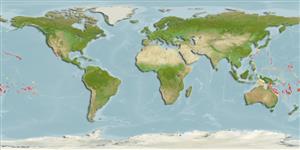Common names from other countries
>
Blenniiformes (Blennies) >
Tripterygiidae (Triplefin blennies) > Tripterygiinae
Etymology: Enneapterygius: Greek, ennea = nine times + Greek, pterygion = little fin (Ref. 45335).
More on author: Fricke.
Environment: milieu / climate zone / depth range / distribution range
Ökologie
seewasser riff-verbunden; tiefenbereich 0 - 30 m (Ref. 54980). Tropical
Central Pacific.
Size / Gewicht / Alter
Maturity: Lm ? range ? - ? cm
Max length : 3.3 cm SL Männchen/unbestimmt; (Ref. 54980)
Kurzbeschreibung
Bestimmungsschlüssel | Morphologie | Morphometrie
Rückenflossenstacheln (insgesamt) : 14 - 19; Rückenflossenweichstrahlen (insgesamt) : 7 - 11; Afterflossenstacheln: 1; Afterflossenweichstrahlen: 16 - 20. Short and slender supraorbital tentacle; first dorsal fin 25% shorter than second dorsal fin; female coloration white with black dots, densest on head and posterior half of body, bearing 6 red Y-shaped bars; male live colors unrecorded; lower side of body of male preserved specimens with 5 to 6 large, dark brown triangular marks, joining ventrally, cheeks with many small dark brown spots, and a dark band below the orbit. Dorsal rays III + XI-XVI + 7-11; lateral line interrupted, 15-20 + 15-20; mandibular pores 3-5 + 0-2 + 3-5 (Ref. 54980).
Eggs are hemispherical and covered with numerous sticky threads that anchor them in the algae on the nesting sites (Ref. 240). Larvae are planktonic which occur primarily in shallow, nearshore waters (Ref. 94114). Feeds on small benthic invertebrates (Ref. 89972). Minimum depth from Ref. 58018.
Life cycle and mating behavior
Maturities | Fortpflanzung | Spawnings | Egg(s) | Fecundities | Larven
Fricke, R., 1994. Tripterygiid fishes of Australia, New Zealand and the southwest Pacific Ocean (Teleostei). Theses Zool. 24:1-585. (Ref. 13227)
IUCN Rote Liste Status (Ref. 130435)
CITES (Ref. 128078)
Not Evaluated
Bedrohung für Menschen
Harmless
Nutzung durch Menschen
Fischereien: nicht kommerziell
Tools
Zusatzinformationen
Download XML
Internet Quellen
Estimates based on models
Preferred temperature (Ref.
115969): 24.7 - 29.4, mean 27.8 (based on 929 cells).
Phylogenetic diversity index (Ref.
82804): PD
50 = 0.5000 [Uniqueness, from 0.5 = low to 2.0 = high].
Bayesian length-weight: a=0.00562 (0.00258 - 0.01228), b=3.08 (2.89 - 3.27), in cm Total Length, based on LWR estimates for this (Sub)family-body shape (Ref.
93245).
Trophic level (Ref.
69278): 3.1 ±0.3 se; based on size and trophs of closest relatives
Widerstandsfähigkeit (Ref.
120179): hoch, Verdopplung der Population dauert weniger als 15 Monate. (Preliminary K or Fecundity.).
Fishing Vulnerability (Ref.
59153): Low vulnerability (10 of 100).
